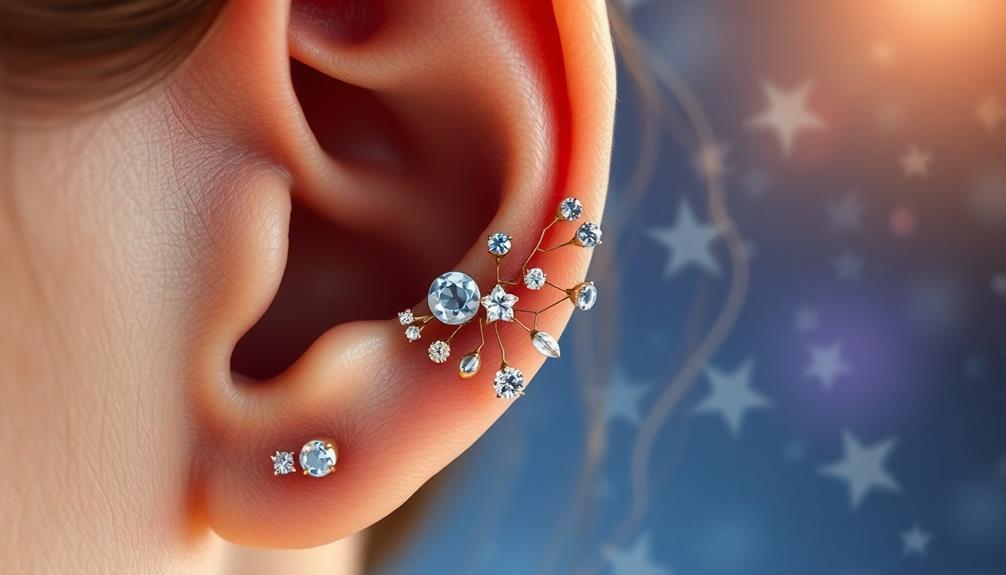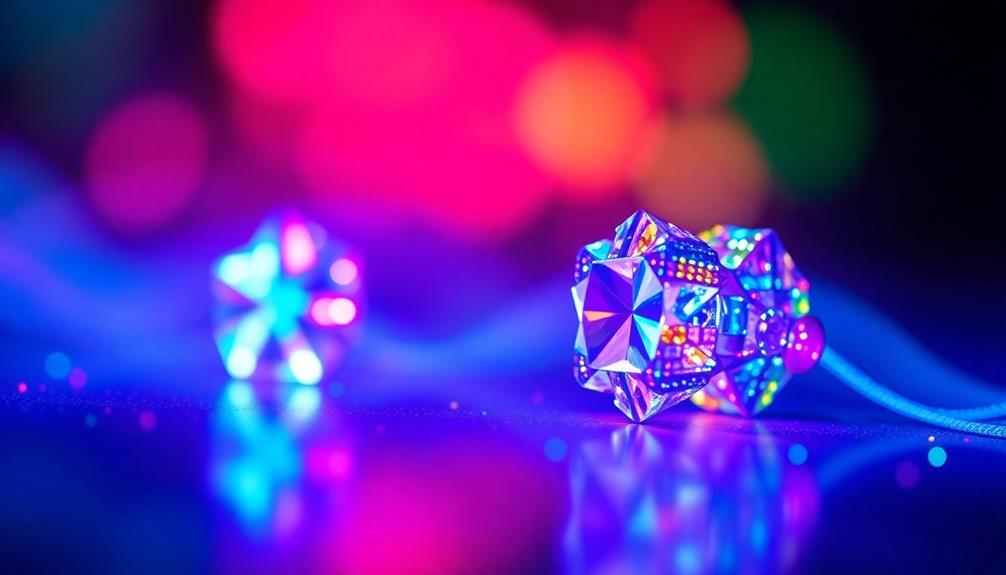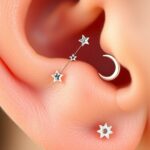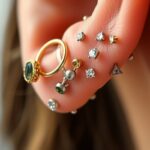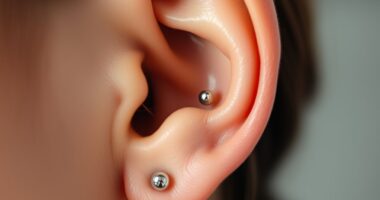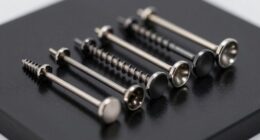Constellation piercings turn your ears into stunning constellations with styles arranged to mimic a starry night. You can opt for symmetrical designs or explore playful patterns along your ear's cartilage. Choosing the right jewelry, like delicate studs or bold hoops, adds to your unique style. Before getting pierced, consult a professional to discuss placement and materials, ensuring they're hypoallergenic. Keep in mind the healing process lasts 6-8 weeks, requiring proper aftercare. With this artistic avenue for self-expression, your ears will truly shine and reflect your personality. Curious about how to style your constellation? There's much more to explore!
Key Takeaways
- Constellation piercings involve multiple earrings arranged to create celestial patterns, enhancing personal style and self-expression.
- Consider ear shape and jewelry materials for optimal placement and comfort during the healing process.
- Healing typically takes 6-8 weeks; proper aftercare is essential to prevent infection and irritation.
- Various earring styles, from studs to hoops, can be mixed for a unique and visually striking design.
- The cost of constellation piercings ranges from $35 to $100, influenced by studio reputation and jewelry quality.
Overview of Constellation Piercings
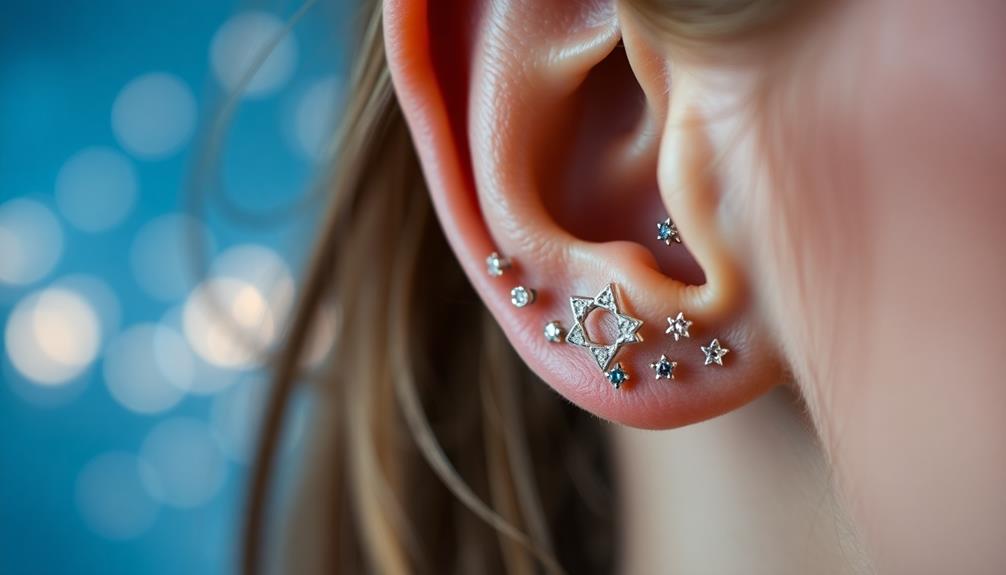
Constellation piercings, with their enchanting arrangements of multiple earrings, offer a unique way to express your personal style while enhancing the overall look of your ears.
These constellation ear piercings involve strategically placed multiple piercings that create stunning star or celestial patterns. You can choose to have them arranged symmetrically along the outer edge or inner cartilage of your ear, allowing for a personalized touch that reflects your individuality.
The trend has exploded on social media platforms like Instagram and TikTok, where influencers and celebrities showcase their creative combinations of body jewelry.
Whether you prefer delicate studs, bold hoops, or playful charms, the options are endless when it comes to designing your constellation. This variety not only enhances the aesthetic appeal of your ears but also invites you to mix and match styles, making each arrangement a true reflection of your personality.
As the interest in constellation piercings continues to grow, it's clear that this trend is here to stay, appealing to various demographics enthusiastic to embrace a fresh and stylish form of ear adornment.
Pre-Piercing Considerations
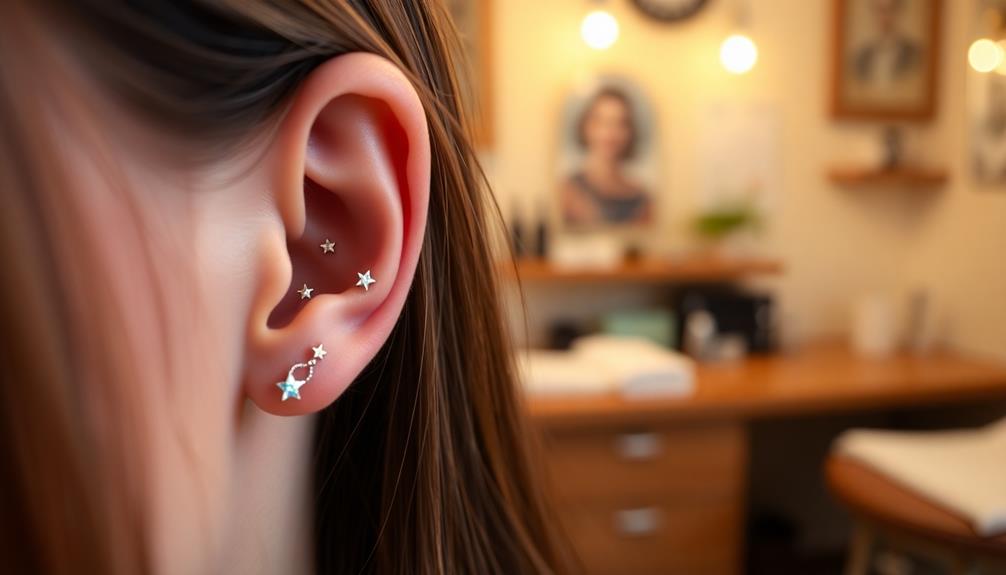
Before diving into the world of constellation piercings, it's important to take into account several factors that can impact your experience and satisfaction. Here are some key pre-piercing considerations to keep in mind:
- Research Styles: Explore different constellation piercing styles and placements that suit your aesthetic. Understanding your options will help you make informed decisions.
- Consult a Professional: Speak with a skilled piercer who can assess your unique ear shape. They'll guide you on the best placement and jewelry options that minimize allergic reactions.
- Choose the Right Jewelry: Selecting hypoallergenic materials like titanium or surgical stainless steel is significant. These options help reduce irritation and guarantee a comfortable healing process.
- Understand Healing: Be prepared to keep your jewelry in place for 6-8 weeks for proper healing. This period is crucial before switching to different styles or jewelry options.
Pain Tolerance and Experience
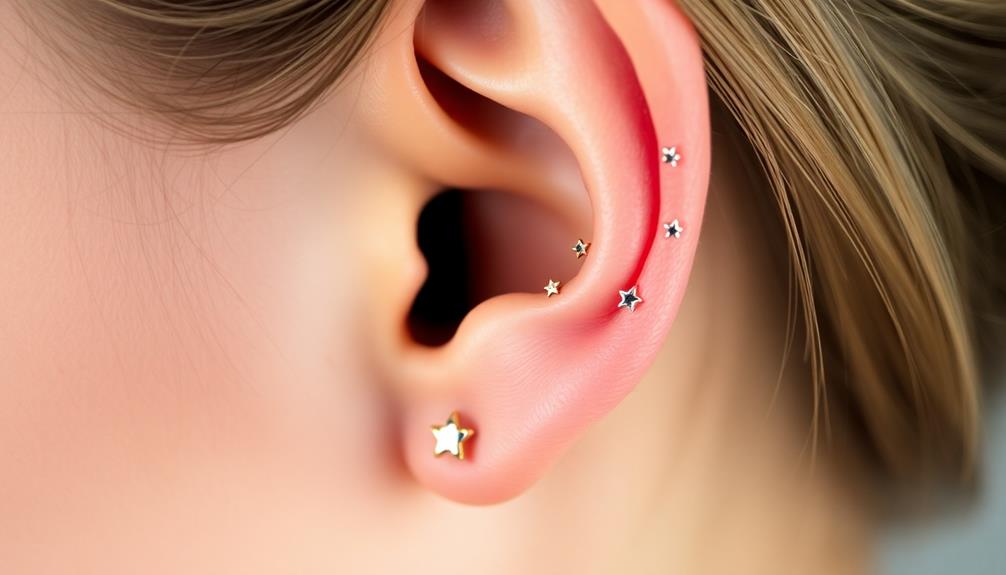
When considering constellation piercings, your pain tolerance plays an essential role in the overall experience.
While most feel only mild to moderate discomfort that fades quickly, everyone's threshold varies.
It's wise to consult a professional piercer for insights on what to expect and how to make the process more comfortable.
Individual Pain Thresholds
How much pain can you really expect from constellation piercings? The answer varies greatly based on your individual pain thresholds. On average, pain levels during ear piercings range from mild to moderate.
However, everyone's experience is unique. If you have a low pain tolerance, you might want to rethink getting multiple piercings done at once, as the cumulative sensation could be more intense than you anticipate. Additionally, humor in playful situations, like getting piercings, can help alleviate anxiety and tension, making the experience more enjoyable seniors texting humor.
Here are a few factors to reflect on regarding your pain experience:
- Personal Pain Tolerance: Everyone perceives pain differently; what feels mild to one person may feel intense to another.
- Number of Piercings: Getting several piercings in one session can heighten discomfort due to the cumulative effect.
- Piercing Technique: The skill of the professional piercer can influence your overall pain experience.
- Preparation and Mindset: Being mentally ready and relaxed can help you manage pain levels effectively.
Consulting with a professional piercer can provide valuable insights into what you might expect. This way, you can make an informed decision that aligns with your comfort levels.
Temporary Discomfort Levels
Experiencing temporary discomfort during constellation piercings is a normal part of the process, and it's important to recognize that pain levels can vary greatly among individuals.
Generally, you can expect the pain to be mild to moderate, depending on your personal pain tolerance. Most people report that the discomfort fades quickly, often within a few minutes, allowing you to enjoy your new piercings without prolonged distress.
If you know you have a low pain tolerance, consider limiting the number of piercings in one session. This approach can help make the experience more manageable.
Remember, temporary discomfort is to be expected, and focusing on proper aftercare can considerably reduce irritation and promote healing.
Aftercare is essential—keeping the area clean and following the piercer's recommendations will make a world of difference in your comfort level post-piercing.
Consulting with a professional piercer beforehand can also provide valuable insights into what to expect regarding pain levels, helping you manage your expectations for the experience.
With the right mindset and care, you'll soon forget any temporary discomfort as you admire your constellation of stars!
Professional Piercing Insights
What factors influence your pain tolerance during constellation piercings? Pain tolerance can vary widely among individuals, often determining how you perceive discomfort during the procedure. Most people report mild to moderate pain, which usually fades quickly.
However, the level of discomfort can be influenced by several factors:
- Area of Piercing: Cartilage piercings tend to be more painful than lobe piercings.
- Personal Pain Threshold: Knowing your own pain tolerance is essential; if you're sensitive, consider spacing out your appointments.
- Relaxation Techniques: Professional piercers often suggest methods to help you relax, reducing the sensation of pain.
- Distraction Methods: Engaging in conversation or listening to music can help take your mind off the procedure.
Aftercare Guidelines
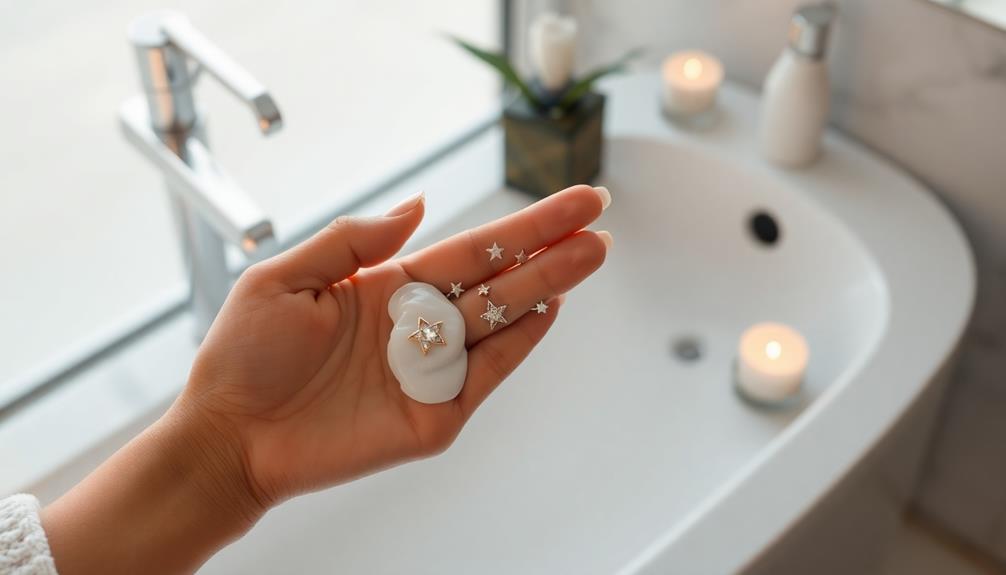
Taking care of your constellation piercings is vital for a smooth healing process. Start by cleaning the piercing site 2-3 times daily with a saline solution. This practice helps prevent infection and promotes healing, so don't skip it.
Avoid touching your piercings with unclean hands, and resist the urge to rotate the jewelry until the area is fully healed.
Keep makeup, lotions, and perfumes away from your piercings to minimize irritation during the healing process.
It's important to remember that swimming in pools, hot tubs, or other bodies of water should be avoided until your piercings have completely healed, which typically takes about 6-8 weeks.
If you notice any signs of infection, such as excessive redness, swelling, or discharge, consult with a professional piercer immediately. They can provide guidance and guarantee that you're following proper aftercare protocols.
Remember, taking these precautions won't only help your piercings heal faster but also keep them looking gorgeous in the long run.
Prioritize your aftercare routine to enjoy your beautiful constellation piercings with confidence!
Cost and Benefits
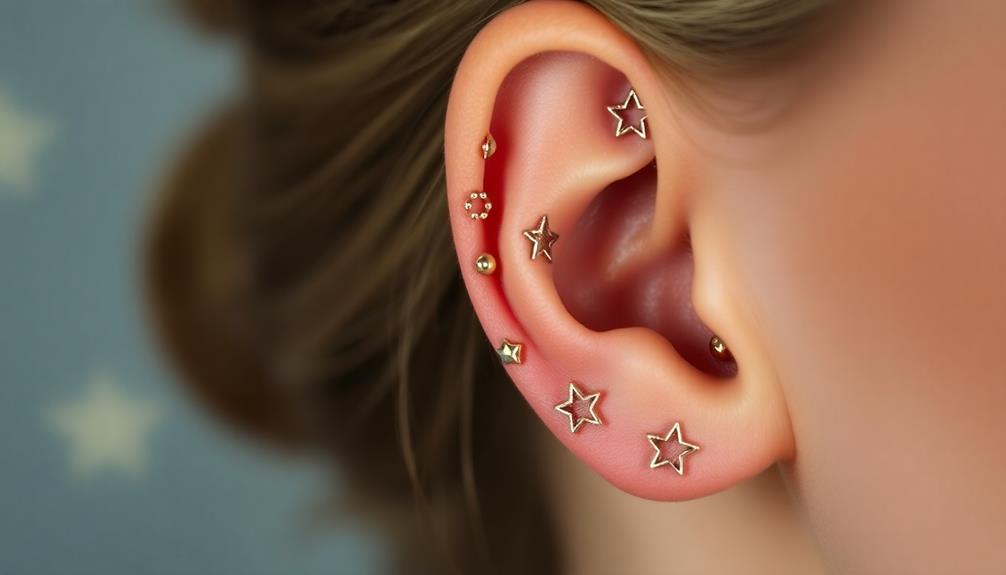
When considering constellation piercings, you'll notice costs typically range from $35 to $100 based on your location and jewelry choice.
The beauty of these piercings lies in their ability to showcase your unique style and create a playful aesthetic that stands out.
Not only do they elevate your look, but they also serve as great conversation starters, boosting your confidence and self-expression.
Pricing Range Overview
Many people find that constellation piercings offer a unique blend of style and personal expression, with prices typically ranging from $35 to $100. The cost can vary based on factors like the location of the piercing studio and the type of body jewelry you choose.
Here's a quick breakdown of what influences the pricing range:
- Studio Reputation: Established studios may charge more due to their experience and quality assurance.
- Jewelry Quality: Investing in high-quality body jewelry not only enhances the look but also minimizes the risk of allergic reactions or infections.
- Customization: Custom options, such as selecting specific earring styles—studs, hoops, or charms—can affect the overall price.
- Location: Urban areas often have higher costs due to increased demand and living expenses.
While the initial investment might seem significant, the benefits of a well-curated ear adornment can boost your confidence and serve as a conversation starter.
As you contemplate your constellation piercings, remember that thoughtful choices in both design and budget will guarantee a rewarding experience.
Unique Self-Expression Benefits
Constellation piercings offer a vibrant avenue for self-expression, allowing you to showcase your individuality in a creative and personal way. These unique ear piercings let you craft designs that reflect your personality, breaking away from the standard patterns often seen in traditional body piercing.
With a price range of $35 to $100, they're an accessible form of body art that won't break the bank. Additionally, much like how music can enhance emotional expression, constellation piercings allow for a deeper connection to your identity through visually striking designs.
One of the greatest benefits of constellation piercings is their ability to enhance your unique look. You can mix and match various jewelry styles, creating a starry arrangement that truly represents who you are. This customization not only makes your piercings visually striking but also empowers you to express your individuality.
Moreover, sporting constellation piercings can boost your confidence. Many people find that these distinctive ear adornments help them feel more connected to their unique identity.
Plus, the playful aesthetic acts as a conversation starter, inviting others to engage with you about your striking body art. As this trend grows, it's clear that constellation piercings are a lasting means of self-expression, making them an enriching addition to any collection of ear piercings.
Aesthetic Appeal Factors
The aesthetic appeal of constellation piercings lies in their combination of affordability and striking design options. With costs typically ranging from $35 to $100, you can express your unique style without breaking the bank. The ability to choose from various types of jewelry enhances the overall aesthetic, allowing for truly personalized designs.
Here are some factors to take into account:
- Customization: You can create unique patterns on your ear that reflect your individuality.
- Versatile Jewelry Options: From studs to hoops to charms, you can mix and match to elevate any outfit.
- Conversation Starters: These eye-catching designs naturally draw attention, encouraging social interaction and boosting your confidence.
- Playful Aesthetic: Their fun and trendy appeal attracts a wide demographic, making them a popular choice among various age groups.
Incorporating constellation piercings into your jewelry collection not only enhances the visual appeal of your ears but also serves as a bold statement of self-expression.
With their affordable price and eye-catching designs, constellation piercings are a fantastic way to showcase your aesthetic while standing out in any crowd.
Choosing Your Constellation Design
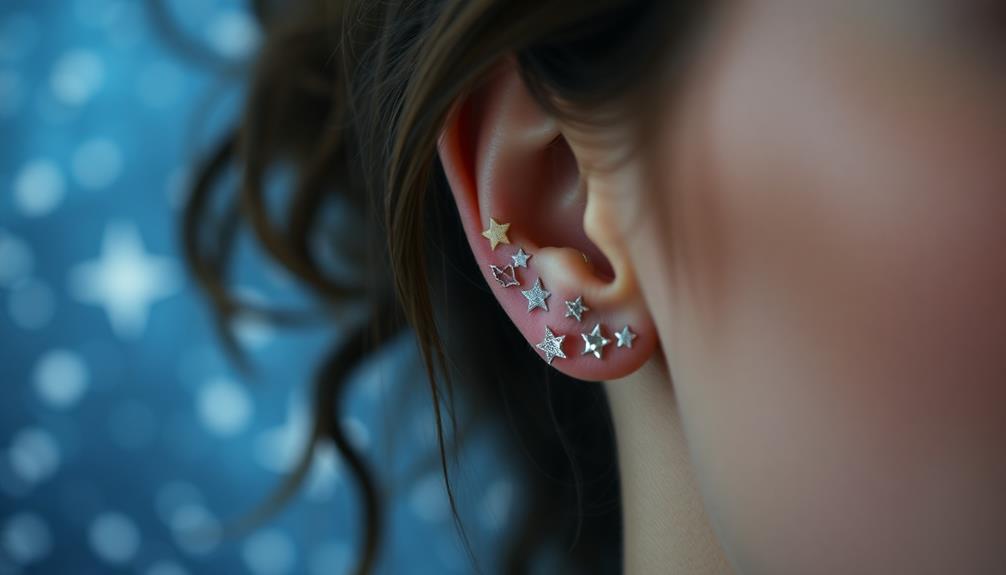
Your choice of constellation design can reflect your unique personality and style, so think carefully about what resonates with you. Consider whether you prefer minimalistic designs featuring just a few piercings for a subtle elegance or more elaborate arrangements that showcase multiple jewelry types for a bold statement. The combination of studs, hoops, chains, and charms should align with your aesthetic preferences.
When planning your constellation, keep your ear shape and size in mind. The arrangement of piercings should enhance your natural features, creating a harmonious look. Mixing various sizes of earrings can add depth and visual interest, resulting in a dynamic constellation pattern on your ear lobe.
Consulting with a professional piercer can provide valuable insights on ideal placement and design ideas tailored specifically to you. Below is a simple table to help you visualize different design options:
| Design Style | Description | Jewelry Types |
|---|---|---|
| Minimalistic | Few piercings for subtle elegance | Small studs |
| Elaborate | Multiple types for bold statements | Hoops, charms, chains |
| Mixed Sizes | Varied sizes for visual interest | Combination of styles |
Healing Time Expectations
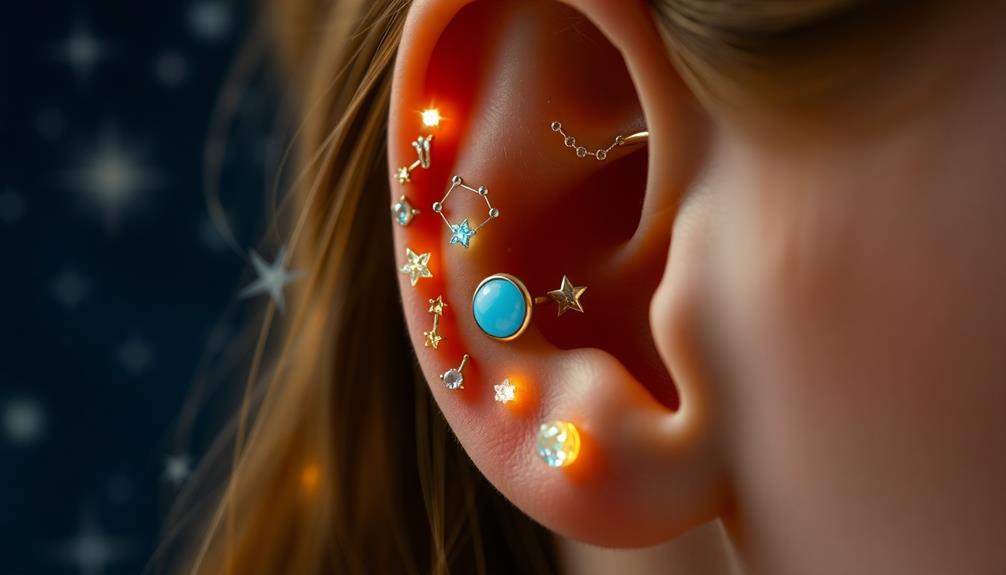
Healing from constellation piercings usually takes about 6 to 8 weeks, and during this time, keeping the original jewelry in place is crucial for proper recovery.
Removing the earrings too soon can cause the piercing holes to close, so it's best to resist the temptation to switch them out early.
To help you navigate the healing process, here are some key tips:
- Stick to a Cleaning Routine: Regular cleaning of your piercings with a saline solution 2-3 times daily promotes healing and prevents infections.
- Don't Touch: Avoid touching or twisting your earrings, as this can irritate the piercing and prolong the healing time.
- Check for Complications: Monitor healing by watching for any signs of redness, swelling, or discharge. If you notice any unusual symptoms, consult your piercer.
- Follow Up: Regular check-ins with a professional piercer can help monitor healing and guarantee everything is progressing smoothly.
Styling Your Ear Constellation
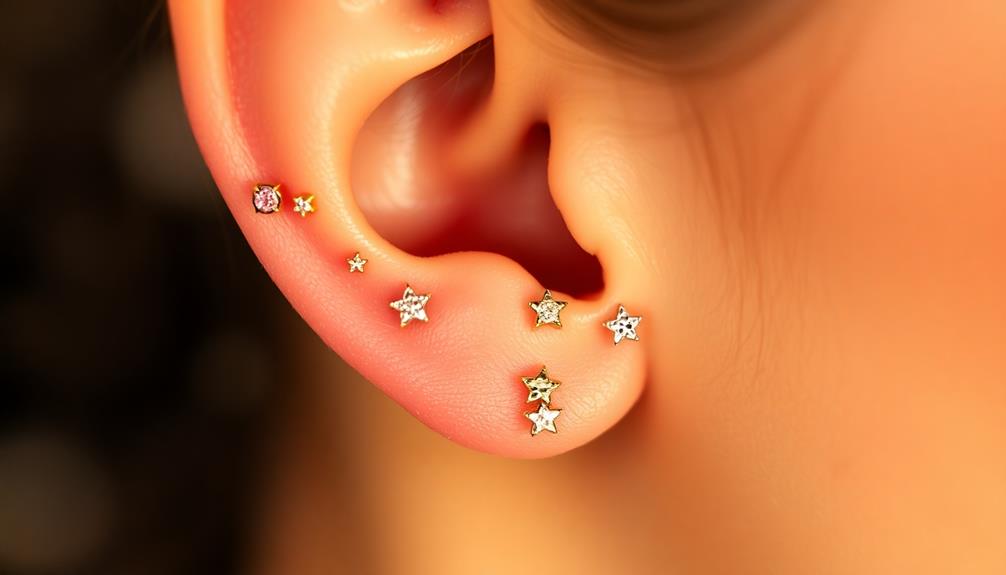
When planning your ear constellation, it's important to reflect on a mix of earring styles, like studs, hoops, and dangles, to create a visually striking arrangement. To achieve this, you should know how different styles can enhance the overall look of your piercings.
Think about incorporating multiple sizes and materials, such as gold, silver, and gemstones, to add depth and flair, mimicking the beauty of a starry night. Additionally, you might want to reflect on how different styling products can help accentuate your overall look, similar to how best hair styling gels can provide a strong hold and enhance your appearance.
Pay attention to the anatomy of your ear, as various shapes and sizes will influence the placement of your piercings. For a balanced arrangement, aim for symmetry or position your earrings in a way that complements your ear's natural contours.
This cohesive look will elevate your constellation design. Don't hesitate to utilize online resources or consult with a professional piercer for inspiration. They can guide you in creating a unique constellation that reflects your individuality.
Frequently Asked Questions
Can I Mix Metals in My Constellation Piercings?
Yes, you can mix metals in your piercings! Just verify the metals are hypoallergenic to avoid irritation. Mixing adds a unique flair, but make certain the overall look aligns with your personal style. Enjoy experimenting!
How Do I Choose the Best Earring Backs?
Choosing earring backs is like picking the right shoes for a dance; you need comfort and support. Go for secure options like lockbacks or screw-on types, ensuring your earrings stay put while you shine.
What if My Piercing Gets Infected?
If your piercing gets infected, don't panic. Clean it gently with saline solution, avoid touching it, and monitor for worsening symptoms. If it doesn't improve in a few days, consult a professional for advice.
Are There Specific Earrings for Cartilage Piercings?
Imagine a treasure chest, filled with jewels just waiting for your ears. Yes, there are specific earrings for cartilage piercings. Opt for studs or hoops designed for comfort and style—your ears deserve the best!
Can I Change My Earrings Before Healing Is Complete?
You shouldn't change your earrings before healing's complete. Doing so can irritate the piercing, increase the risk of infection, or delay the healing process. It's best to wait until your piercings are fully healed.
Conclusion
In the end, constellation piercings aren't just about aesthetics; they're a cosmic connection to your personal style. Imagine your ears adorned with tiny stars, each representing a cherished memory or dream. As you look in the mirror, you see a galaxy uniquely yours, glimmering with stories only you know. So go ahead, embrace this celestial art form, and let your ears shine like the night sky, reminding you of the beauty in individuality and self-expression.

